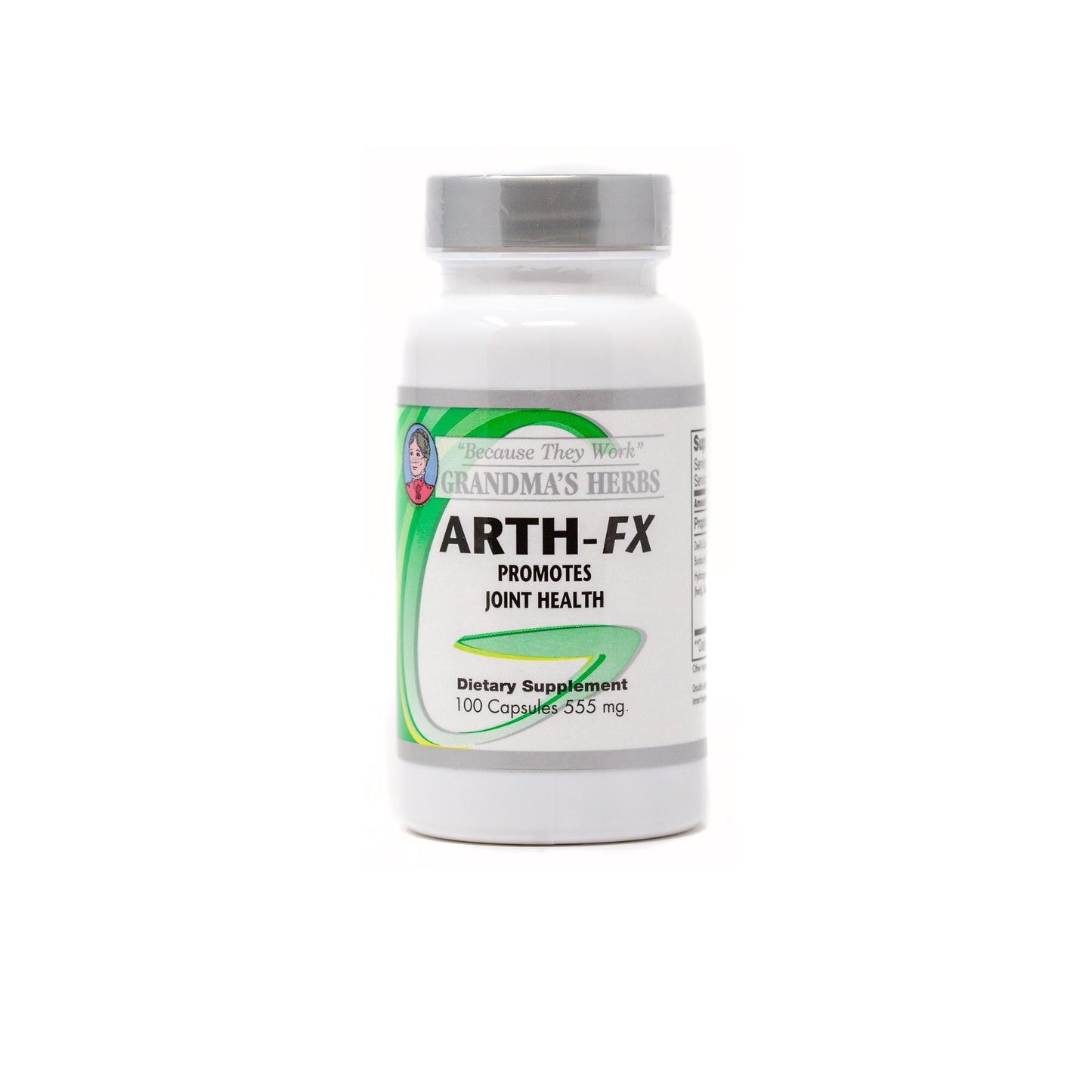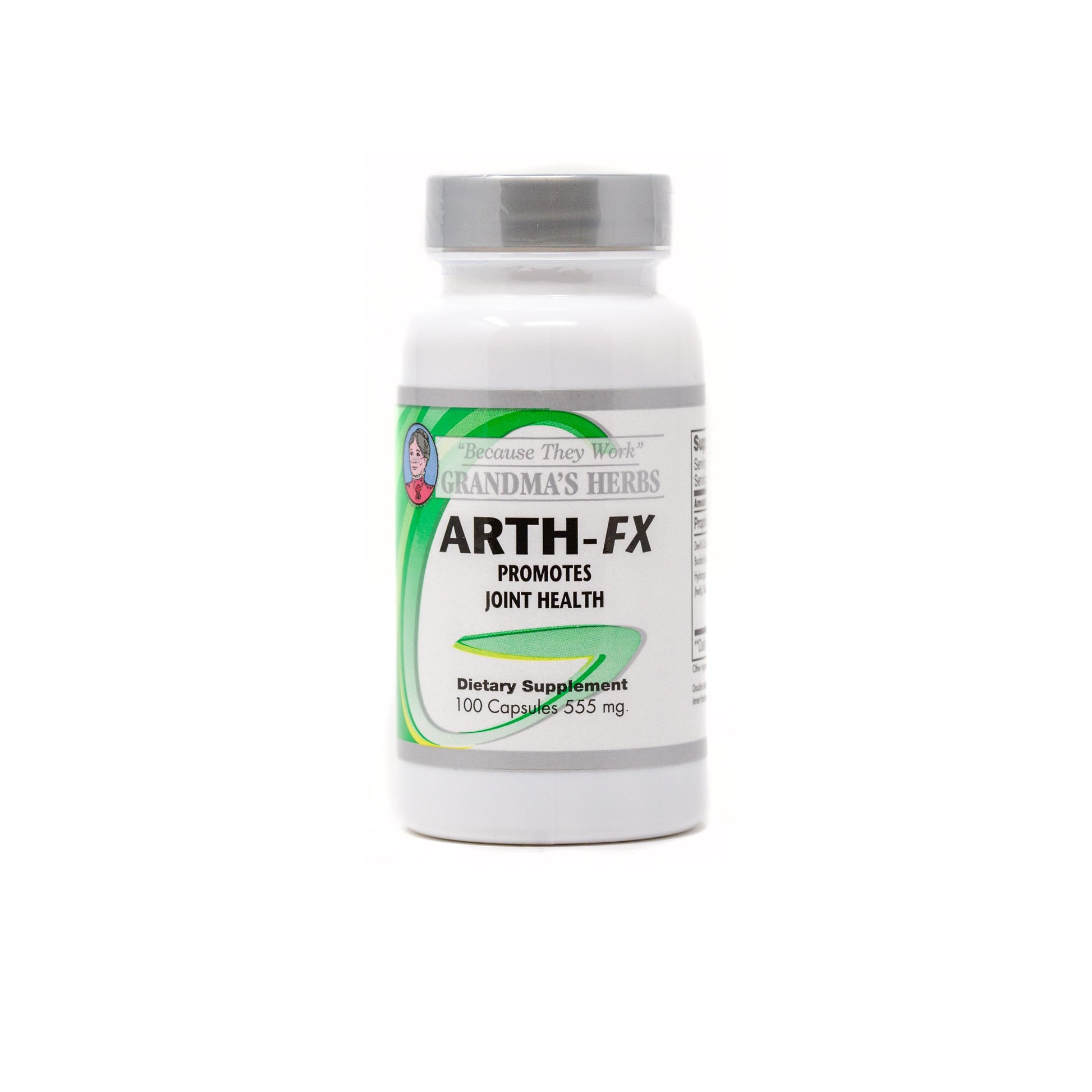Grandma's Herbs
Arth-FX
Arth-FX
Couldn't load pickup availability
Research:
Devil's Claw
- Devil’s claw is a flowering plant of the sesame family. It gets its name from the fruit that has a hook on it and resembles a claw.
- Devil's Claw root packs several active plant compounds. The roots are the parts used as an herbal supplement.
- Devil's Claw was originally discovered by South African natives. It was introduced to Europeans in the early 1900's. The roots were used to promote healthy joint mobility.
- It is believed that the iridois glycosides, particularly harpagoside are the reason that Devil’s Claw was such a popular herb to use.
- Today Devil's Claw is a common herb used in Germany and France to support healthy joint mobility and function.
White Willow Bark
- The bark of the white willow contains salicin.
- White Wollow Bark may promote healthy joint mobility.
- White Willow Bark also has powerful plant compounds called flavonoids. The combination of the flavonoids and salicin are thought to be responsible for the effects of the herb.
- Willow trees are members of the Salicaceae plant family and are native to Europe, Central Asia and Northern Africa.
-
There are a number of species of willow trees in existence that produce bark that is used to make extracts, and supplements. These include the species:
White Willow or European willow
Black Willow or Pussy Willow
Crack Willow
Purple Willow - Once salicin is absorbed it breaks down to various salicylate derivatives, which have a variety of health-promoting capabilities.
Alfalfa
- According to the University of Rochester Medical Center, "The use of Alfalfa is considered safe and seems to increase certain immune system functions."
- Herbalists both past and present claim that Alfalfa is one of the best all inclusive herbal supplements on the market because it contains many minerals, vitamins, and other nutrients that play a crucial role in overall health and well-being.
- Alfalfa is a "best practices" herb to use for continued maintenance of a healthy body.
- Alfalfa contains protein as well as vitamin A, vitamin B1, vitamin B6, vitamin C, vitamin E, and vitamin K. It also contains carotene, calcium, potassium, zinc, and iron. It can be taken in the form of leaves, tablets, or seeds.
Red Clover
- Evidence suggests that red clover helps with bone health because of the micro-nutrients it contains.
- Red Cover contains an extremely high amount of phytoestrogenic isoflavones.
- Diets that contain high levels of phytoestrogenic isoflavones are associated with a high rate of skeletal health.
- Red clover contains many different isoflavones (daidzein, genistein, formononetin, and biochanin A), which are a type of polyphenols with antioxidant and other health benefits.
- The mechanism of action for Red Clover is related to the isoflavones daidzein, genistein, formononetin, and biochanin A which all inhibit COX enzyme activity.
- COX enzyme activity suppresses prostaglandin synthesis; prostaglandin helps immunosuppression which which can promote joint health.
The information above is for informational purposes only. They do not reflect or relate to the performance or purpose of any products that contain the ingredients being described on this page.
* "Herbal supplements are not drugs. They are not intended to diagnose, treat, cure or prevent any disease.*
Help Me Choose:
Joints in the Human Body and Their Issues
When reading this article please keep in mind that supplements are not drugs. They are not intended to diagnose, treat, cure or prevent any disease. These articles are truly just for your information.
What exactly is a joint?
- Joints, also known as articulations, are strong connections that join the bones and cartilage of the body to one another. Each joint is specialized in its shape and structural components to control the range of motion between the parts that it connects.
What are the different types of joints in the human body?
- Ball and Socket Joints
- This type of joint allows for a wide range of rotation and movement, including rotation. Your shoulder and hip are examples of ball and socket joints.
- Condyloid Joints
- The jaw and fingers both have condyloid joints. These joints don't allow rotation, but are versatile and hard working joints.
- Gliding Joints
- The spine ankle and wrist are these kind of joints. They allow bones to glide around and past each other.
- Hinge Joints
- Just like the name suggests, these joints work like hinges. Think of your knee and the part of your elbow that bends like a hinge.
- Pivot Joints
- Your neck and elbow both have pivot joints, which allow bones to pivot or twist around other bones.
- Saddle Joint
- The best example of a saddle joint and what it does is found in the base of the thumb. Saddle joints allow side to side and back and forth motion, but don't fully rotate.
There are some terms that are commonly used to describe the motion of the bones at either end of the joint.
- Range of Motion
- A majority of the human body’s joints allow for movement. A few, like joints in the skull, do not. Joints that do allow for motion, such as the knee or ankle, have a predetermined range of motion, which is basically how far in each direction that joint can move or bend comfortably.
- The range of motion of a joint is usually measured in degrees. Typically, the extension of a joint is limited to 180 degrees or less. In other words, that joint can be opened until it is straight. Think of your elbow or knee as an example: they can be bent until the upper parts and lowre parts are touching each other or the can be rotated until they're just about straight, but can't be pushed beyond 180 degrees without pain or damage.
- Extension
- Extension is the moving of the parts joined together in the joint so that the bones forming the joint are moved farther apart, or straightened. This is a physical position that decreases the angle between the bones of the limb at a joint. It occurs when muscles contract and bones move the joint into a bent position.
- Flexion
- Flexion is the bending of a particular joint so that the bones that form that joint are pulled closer together. During flexion, the angle between the bones of a limb at a joint is decreased. Flexion typically occurs when muscles contract and the bones thus move the nearby joint into a curved position. Flexion is a physical position that decreases the angle between the bones of the limb at a joint. It occurs when muscles contract and bones move the joint into a bent position.
How many joints does the human body have?
- There are 360 joints in the human body. All of them are subject to wear and tear.
- There are 66 thorax (chest) joints.
- 76 joints in your spine and pelvis.
- Your hands have 27 joints each to total 54 well used joints.
- Your feet and ankles have 33 joints which totals 66 joints that get walked on every day.
- That still leaves hips, knees, shoulders, elbows and wrists.
Issues with Joints:
- Joint Pain
- Most joint pain is suffered in hands, feet, legs, arms and back. These are the joints used to perform the "heavy lifting" in life's daily tasks.
- Another issue is aging joints. Aging joints can have different issuses;
- Temporary aches and pains
- Mechanical Issues (Range of motion)
- Both are characterized by joint pain and possibly the loss of some range of motion.
- Joint wear and tear can cause pain can be debilitating. The lives of anyone with joint pain may be severely altered in lieu of the pain and loss of "range of motion".
- Exercise is very beneficial for people who have joint pain.
- Some of the exercises most beneficial are in the Tai Chi and Yoga disiplines. Although one should be sure to consult a health care professional before starting an exercise regimin.
- Proper diet is also very important when it come to joint health and longevity. There are hundreds of reasons why plus thousands of foods that could be placed on either the avoid list or the consume list below. It might be best to list just a few things to give you the idea.
- Foods to avoid:
- Sugars and refined carbs
- Alcohol and tobacco
- Salt and preservatives
- An Advanced Glycation End product (AGE) is a toxin that appears when foods are heated, grilled, fried, or pasteurized. So AGE is something to avoid when talking about joint health... (hahaha)
- Foods to consume:
- Super fruits like cherries, blue berries, raspberries, black berries and pomegranites.
- All have antioxidants and a chemical compound called anthocyanins to promote joint health.
- Peppers like red peppers and cayenne.
- Peppers are known to assist with circulation. Most peppers have an abundance of vitamin C. Vitamin C helps your body make collagen. Collagen is a part of your cartilage, tendons and ligaments that cushion your joints and hold them together.
- Other similar foods are citrus fruits, pineapple and tomatoes.
- Dark Green Leafy Vegatables
- Kale, broccoli, bok choy, collard greens and other dark, leafy greens are rich in nutrients that are linked to joint health, including the antioxidants beta-carotene and vitamin C. They are also an excellent source of calcium and other minerals which help to keep your bones strong.
- Raw Nuts like Walnuts, Almonds, Peanuts and Pecans.
- There are a lot of nuts that have healthy amounts of antioxidants in them which we know are good for our joints. They also contain a form of Omega 3 fatty acid that is good for the joints.
The information listed above is for informational purposes only. It does not reflect or relate to the performance or purpose of any products on this website.
* "Herbal supplements are not drugs. They are not intended to diagnose, treat, cure or prevent any disease.*
Health Information:
Joints: What To Do As We Age?
How many times have you gotten out of bed in the morning and noticed that it takes a little time and effort to start moving freely? Do you feel better after a warm shower? Most American's over the age of forty can answer "yes" to those questions and many others related to joint pain.
Ingredients:
Devil's Claw (root), Yacca (root), Chaparral (herb), Burdock (root), White Willow (bark), Alfalfa (leaf), Hydrangea (root), Red Clover (tops), Horsetail Grass (herb), Skullcap (herb), Bladder Pod (herb)
Instructions:
2 Capsules twice a day 1/2 hour before meals.
What's Included:
1 Bottle of Grandma's Herbs ARTH-FX* - 100 Capsules - 555 mg.
Features:
This natural herbal formula is for healthy joint support.
The information listed above is for informational purposes only. It does not reflect or relate to the performance or purpose of any products on this website.
* "Herbal supplements are not drugs. They are not intended to diagnose, treat, cure or prevent any disease.*
Share




